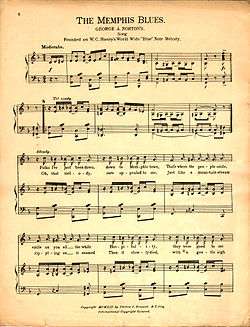Memphis blues
| Memphis blues | |
|---|---|
| Stylistic origins | |
| Cultural origins | 1910s-1930s, Memphis, Tennessee, United States |
| Typical instruments | |

The Memphis blues is a style of blues music that was created in the 1910s – 1930s by Memphis-area musicians like Frank Stokes, Sleepy John Estes, Furry Lewis and Memphis Minnie. The style was popular in vaudeville and medicine shows and was associated with Memphis's main entertainment area, Beale Street. W.C. Handy, the "Father of the Blues" published the song "The Memphis Blues". In lyrics, the phrase has been used to describe a depressed mood.[1]
History
 |
"The Memphis Blues" (1914)
"The Memphis Blues" (1914), composed by W. C. Handy in 1912 and recorded by Victor Military Band in 1914. First known commercial recording of Handy's first commercially successful blues composition. |
| Problems playing this file? See media help. | |
In addition to guitar-based blues, jug bands, such as Gus Cannon's Jug Stompers and the Memphis Jug Band, were extremely popular practitioners of Memphis blues. The jug band style emphasized the danceable, syncopated rhythms of early jazz and a range of other folk styles. It was played on simple, sometimes homemade, instruments such as harmonicas, violins, mandolins, banjos, and guitars, backed by washboards, kazoo, guimbarde and jugs blown to supply the bass.
Electric blues
After World War II, as African-Americans left the Mississippi Delta and other impoverished areas of the South for urban areas, many musicians gravitated to the blues scene in Memphis, changing the classic Memphis blues sound. Musicians such as Howlin' Wolf, Willie Nix, Ike Turner, and B.B.King performed on Beale Street and in West Memphis and recorded some of the classic electric blues, rhythm and blues and rock & roll records for labels such as Sam Phillips's Sun Records. Sun recorded Howlin' Wolf (before he moved to Chicago), Willie Nix, Ike Turner, B.B.King and others.[2] Electric Memphis blues featured "explosive, distorted electric guitar work, thunderous drumming, and fierce, declamatory vocals."[3] Musicians associated with Sun Records included Joe Hill Louis, Willie Johnson and Pat Hare.[4][5]
Memphis blues musicians
- Albert King
- B. B. King
- Bobby Sowell
- Doctor Ross
- Elvis Presley
- Frank Stokes
- Furry Lewis
- Gus Cannon
- Howlin' Wolf
- Ida Cox
- James Cotton
- Joe Hill Louis
- John Lee Hooker
- Junior Parker
- Junior Wells
- Little Milton
- Memphis Minnie
- Mississippi John Hurt
- Mose Vinson
- Noah Lewis
- Pat Hare
- Sleepy John Estes
- Robert Wilkins
- Rosco Gordon
- Willie Johnson
- Willie Nix
See also
References
- ↑ Tony Bolden, Afro-Blue: Improvisations in African American Poetry and Culture, 2004, University of Illinois Press, ISBN 978-0-252-02874-8
- ↑ J. Broven, Record Makers and Breakers: Voices of the Independent Rock ʹnʹ Roll Pioneers Music in American Life (University of Illinois Press, 2009), pp. 149–154.
- ↑ "Electric Memphis Blues Music Genre Overview". AllMusic. Retrieved 2016-10-21.
- ↑ Robert Palmer, "Church of the Sonic Guitar", pp. 13-38 in Anthony DeCurtis, Present Tense, Duke University Press, 1992, pp. 24-27. ISBN 0-8223-1265-4.
- ↑ DeCurtis, Anthony (1992). Present Tense: Rock & Roll and Culture (4. print. ed.). Durham, N.C.: Duke University Press. ISBN 0822312654.
His first venture, the Phillips label, issued only one known release, and it was one of the loudest, most overdriven, and distorted guitar stomps ever recorded, 'Boogie in the Park' by Memphis one-man-band Joe Hill Louis, who cranked his guitar while sitting and banging at a rudimentary drum kit.